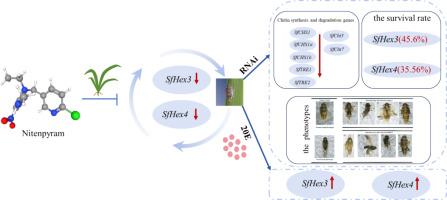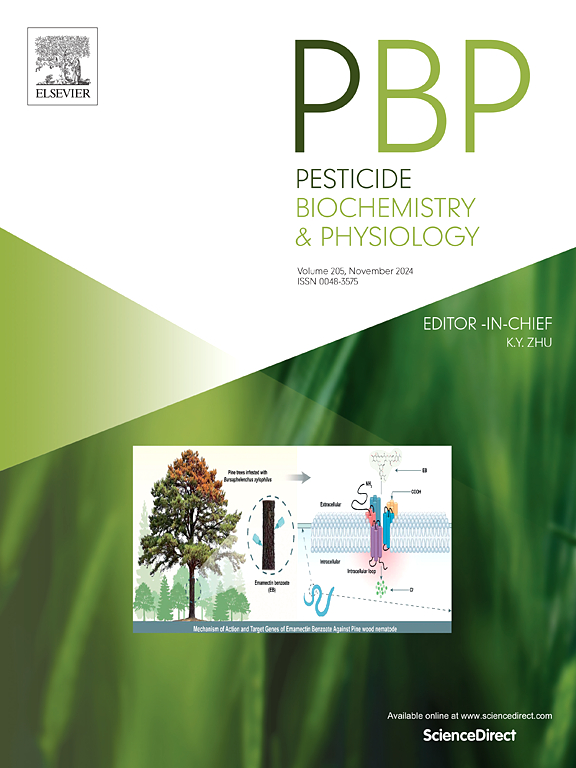用RNA干扰法敲低白背飞虱的β- n -乙酰己糖氨酸酶基因,抑制了飞虱的脱毛,提高了飞虱的死亡率
IF 4.2
1区 农林科学
Q2 BIOCHEMISTRY & MOLECULAR BIOLOGY
引用次数: 0
摘要
β- n -乙酰氨基葡萄糖酶和/或β- n -乙酰己糖氨酸酶(nag / Hexes)是重要的外切酶,在昆虫的蜕皮过程中起着至关重要的作用。SfHex3和SfHex4含有GH20和GH20b的保守催化结构域,分别聚集在NAG2和NAG1基团中。SfHex3和SfHex4主要在4 ~ 5龄若虫、被皮和子房中高表达。SfHex3在雄性和雌性成虫体内的表达量逐渐降低,雌性成虫第一天SfHex4的表达量显著高于雄性成虫第一天。此外,RNA干扰(RNAi)结果表明,下调SfHex3和SfHex4在5龄若虫体内的表达可导致脱皮失败和高死亡率。此外,SfHex3和SfHex4 RNAi后,几丁质代谢途径关键基因(SfCHS1、SfCHS1a、SfCHS1b、SfTRE1、SfTRE2、SfCht5和SfCht7)的转录水平与对照组相比显著降低。同时,在20E处理6 h和12 h后,SfHex3和SfHex4的表达水平上调。SfHex3和SfHex4的转录水平在处理96 h后,在nitenpyram LC20、LC50和LC90处被显著抑制。综上所述,SfHex3和SfHex4在蜜蛾若虫发育过程中起着重要的作用,参与了蜜蛾从若虫到成虫的蜕皮过程。该研究不仅加深了我们对nitenpyram在害虫防治中的认识,而且为利用RNAi靶向SfHex3和SfHex4开发新的防治策略提供了基础。本文章由计算机程序翻译,如有差异,请以英文原文为准。

Knockdown of the β-N-acetylhexosaminidase genes by RNA interference inhibited the molting and increased the mortality of the white-backed planthopper, Sogatella furcifera
β-N-Acetylglucosaminidases and/or β-N-acetylhexosaminidases (NAGs / Hexes) are crucial exonucleases, playing a crucial role in the insect molting process. SfHex3 and SfHex4 contain conserved catalytic domains of GH20 and GH20b, clustered into NAG2 and NAG1 group, respectively. SfHex3 and SfHex4 were mainly highly expressed in the 4th–5th instar nymphs, as well as in the integument and ovary. The expression level of SfHex3 gradually decreased in male and female adults, and SfHex4 on the first day of female was significantly higher than that on the first day of male. In addition, RNA interference (RNAi) results demonstrated that the downregulation of SfHex3 and SfHex4 expression in 5th-instar nymphs resulted in failed molting, and a high mortality. Furthermore, after RNAi with SfHex3 and SfHex4, the transcript levels on key genes of the chitin metabolism pathway (SfCHS1, SfCHS1a, SfCHS1b, SfTRE1, SfTRE2, SfCht5, and SfCht7) were significantly decreased compared to the control group. Meanwhile the expression levels of SfHex3 and SfHex4 were up-regulated after 6 h and 12 h of 20E treatment. And the transcription levels of SfHex3 and SfHex4 were significantly inhibited at nitenpyram LC20, LC50, and LC90 after 96 h of treatment, in 3rd nymphs of Sogatella furcifera. In conclusion, SfHex3 and SfHex4 play important roles in the nymphal development of S. furcifera, contributing to the molting process from nymph to adult. This study not only enhances our understanding of the nitenpyram in pest control, but also provides a foundation for the development of new control strategies using RNAi to targeting SfHex3 and SfHex4.
求助全文
通过发布文献求助,成功后即可免费获取论文全文。
去求助
来源期刊
CiteScore
7.00
自引率
8.50%
发文量
238
审稿时长
4.2 months
期刊介绍:
Pesticide Biochemistry and Physiology publishes original scientific articles pertaining to the mode of action of plant protection agents such as insecticides, fungicides, herbicides, and similar compounds, including nonlethal pest control agents, biosynthesis of pheromones, hormones, and plant resistance agents. Manuscripts may include a biochemical, physiological, or molecular study for an understanding of comparative toxicology or selective toxicity of both target and nontarget organisms. Particular interest will be given to studies on the molecular biology of pest control, toxicology, and pesticide resistance.
Research Areas Emphasized Include the Biochemistry and Physiology of:
• Comparative toxicity
• Mode of action
• Pathophysiology
• Plant growth regulators
• Resistance
• Other effects of pesticides on both parasites and hosts.

 求助内容:
求助内容: 应助结果提醒方式:
应助结果提醒方式:


